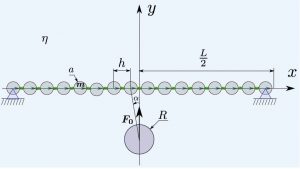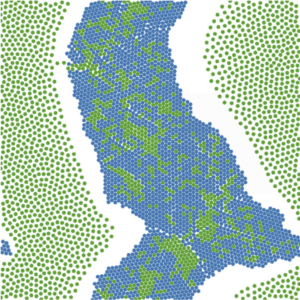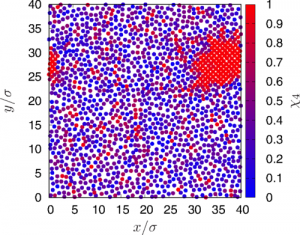Publications
PUBLICATIONS 2021-2023
Geometrical characterization of active contraction pulses in epithelial cells using the two-dimensional vertex model
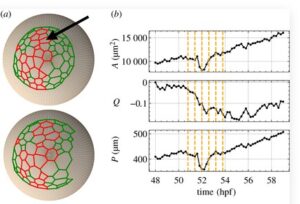 During the embryonic development of the annual fish, some cells of the embryo contract for a few hours and then return to their original size. The forces that cause this contraction could not be determined experimentally. To do this, we created a physical-mathematical model of the embryonic tissue and studied it computationally, where we could apply the contraction forces wherever we wanted. We were able to show that it is not the same: the forces at the edge produce more round cells, while at the surface they produce more elongated cells, among other things.
During the embryonic development of the annual fish, some cells of the embryo contract for a few hours and then return to their original size. The forces that cause this contraction could not be determined experimentally. To do this, we created a physical-mathematical model of the embryonic tissue and studied it computationally, where we could apply the contraction forces wherever we wanted. We were able to show that it is not the same: the forces at the edge produce more round cells, while at the surface they produce more elongated cells, among other things.
Geometrical characterization of active contraction pulses in epithelial cells using the two-dimensional vertex model
Fernanda Pérez-Verdugo, Germán Reig, Mauricio Cerda, Miguel L. Concha and Rodrigo Soto
Journal of the Royal Society Interface. January 2022.
https://doi.org/10.1098/rsif.2021.0851
Variance in Landscape Connectivity Shifts Microbial Population Scaling
 This study investigates the spatial ecology of soil microbes, which is essential for determining their impact on large scale ecosystem services, such as carbon sequestration, climate regulation and nutrient cycling. Emulating this complex physicochemical environment as a patchy habitat landscape, we investigated on-chip the effect of changing the connectivity features of this landscape as Escherichia coli forms a metapopulation.
This study investigates the spatial ecology of soil microbes, which is essential for determining their impact on large scale ecosystem services, such as carbon sequestration, climate regulation and nutrient cycling. Emulating this complex physicochemical environment as a patchy habitat landscape, we investigated on-chip the effect of changing the connectivity features of this landscape as Escherichia coli forms a metapopulation.
Variance in Landscape Connectivity Shifts Microbial Population Scaling
Miles T. Wetherington, Krisztina Nagy, László Dér, Janneke Noorlag, Peter Galajda and Juan E. Keymer.
Front. Microbiol., Volume 13, 01 April 2022
DOI: https://doi.org/10.3389/fmicb.2022.831790
Study of the interaction of folic acid-modified gold nanorods and fibrinogen through microfluidics: implications for protein adsorption, incorporation and viability of cancer cells
 Gold nanoparticles (GNPs) have potential use in medical treatments (such as destroying cancer cells) because of their ability to target specific sites in the body. But before they can be used, it’s important to know how they interact with proteins in the bloodstream. In this study, the interaction between gold nanoparticles and plasma proteins is investigated using microfluidic devices.
Gold nanoparticles (GNPs) have potential use in medical treatments (such as destroying cancer cells) because of their ability to target specific sites in the body. But before they can be used, it’s important to know how they interact with proteins in the bloodstream. In this study, the interaction between gold nanoparticles and plasma proteins is investigated using microfluidic devices.
Study of the interaction of folic acid-modified gold nanorods and fibrinogen through microfluidics: implications for protein adsorption, incorporation and viability of cancer cells
Nacaroha Orellana, Sujey Palma, Estefania Torres, María Luisa Cordero, Valentina Vio, Juan M. Ruso, Josué Juárez, Antonio Topete, Eyleen Araya, Rodrigo Vasquez-Contreras, Marcelo J. Kogan y Natalia Hassan.
Nanoscale, 2021, 13, 17807
DOI: 10.1039/d1nr03179a
Ecological succession and the competition-colonization trade-off in microbial communities
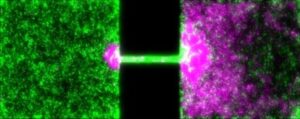 Competition-colonization is a dichotomy at the core of ecological succession. In bacterial communities, this trade-off is a fundamental mechanism for the understanding of spatio-temporal fluxes in micriobiome composition. Using microfluidic devices as structured bacterial habitats, we show that, in a synthetic two-species community of motile strains, Escherichia coli is a fugitive species, whereas Pseudomonas aeruginosa is a slower colonizer but superior competitor.
Competition-colonization is a dichotomy at the core of ecological succession. In bacterial communities, this trade-off is a fundamental mechanism for the understanding of spatio-temporal fluxes in micriobiome composition. Using microfluidic devices as structured bacterial habitats, we show that, in a synthetic two-species community of motile strains, Escherichia coli is a fugitive species, whereas Pseudomonas aeruginosa is a slower colonizer but superior competitor.
Ecological succession and the competition-colonization trade-off in microbial communities
Miles T. Wetherington, Krisztina Nagy, László Dér, Ágnes Ábrahám, Janneke Noorlag,
Peter Galajda & Juan E. Keymer
BMC Biology volume 20, Article number: 262 (2022)
https://bmcbiol.biomedcentral.com/articles/10.1186/s12915-022-01462-5
Diversity of self-propulsion speeds reduces motility-induced clustering in confined active matter
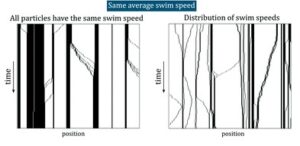 It has been known for some time that bacteria and other micro-organisms tend to cluster together simply because they are persistent. This is a purely physical effect that does not require chemical or biological signals. In narrow channels, this effect is enhanced because bacteria have little room to escape. On the other hand, in nature, bacteria are not all the same and have a diversity of speeds. In this article, we investigate how this diversity affects cluster formation and show that the more diverse the population, the more difficult it is to form these clusters, which can have a very negative effect on flow in catheters or channels in the kidney, for example.
It has been known for some time that bacteria and other micro-organisms tend to cluster together simply because they are persistent. This is a purely physical effect that does not require chemical or biological signals. In narrow channels, this effect is enhanced because bacteria have little room to escape. On the other hand, in nature, bacteria are not all the same and have a diversity of speeds. In this article, we investigate how this diversity affects cluster formation and show that the more diverse the population, the more difficult it is to form these clusters, which can have a very negative effect on flow in catheters or channels in the kidney, for example.
Diversity of self-propulsion speeds reduces motility-induced clustering in confined active matter
Pablo de Castro, Francisco M. Rocha, Saulo Diles, Rodrigo Soto and Peter Sollich
Soft Matter, Issue 43, 2021.
https://pubs.rsc.org/en/content/articlelanding/2021/SM/D1SM01009C
Apical contacts stemming from incomplete delamination guide progenitor cell allocation through a dragging mechanism
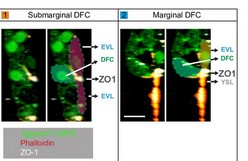 In this article, an early-stage fish embryo was studied in which some cells from an external tissue become internalized and give rise to some of the fish’s organs. The question is how these cells, although no longer part of the external tissue, continue to move with it to reach the position where they will form the organ. Using microscopic image analysis and computational modeling, we show that these cells continue to be pulled mechanically by the cells above and below them, with forces that we have been able to measure and model.
In this article, an early-stage fish embryo was studied in which some cells from an external tissue become internalized and give rise to some of the fish’s organs. The question is how these cells, although no longer part of the external tissue, continue to move with it to reach the position where they will form the organ. Using microscopic image analysis and computational modeling, we show that these cells continue to be pulled mechanically by the cells above and below them, with forces that we have been able to measure and model.
Apical contacts stemming from incomplete delamination guide progenitor cell allocation through a dragging mechanism
Eduardo Pulgar, Cornelia Schwayer, Néstor Guerrero, Loreto López, Susana Márquez, Steffen Härtel, Rodrigo Soto, Carl-Philipp Heisenberg, Miguel L Concha
eLife, Developmental Biology, August 2021
https://doi.org/10.7554/eLife.66483
Kinetic modeling of the chemotactic process in run-and-tumble bacteria
 Chemotaxis is the process by which living things move toward (or away from) a chemical signal, such as a food or a toxin. Bacteria are very small for their environment, and what they do is swim and change direction from time to time. In this article, we use equations with parameters that we have measured experimentally to calculate how efficient chemotaxis is in bacteria. To do this, we calculate their mobility and show that bacteria have a time delay that causes them not to reach the food exactly, but to be “off” by a few hundred microns. This may be relevant to the ecology of bacteria in very confined environments.
Chemotaxis is the process by which living things move toward (or away from) a chemical signal, such as a food or a toxin. Bacteria are very small for their environment, and what they do is swim and change direction from time to time. In this article, we use equations with parameters that we have measured experimentally to calculate how efficient chemotaxis is in bacteria. To do this, we calculate their mobility and show that bacteria have a time delay that causes them not to reach the food exactly, but to be “off” by a few hundred microns. This may be relevant to the ecology of bacteria in very confined environments.
Kinetic modeling of the chemotactic process in run-and-tumble bacteria
Andrea Villa-Torrealba, Simón Navia, and Rodrigo Soto
Phys. Rev. E 107, 034605, March 2023
https://journals.aps.org/pre/abstract/10.1103/PhysRevE.107.034605
Spatiotemporal structures and heterogeneities are common in natural habitats, yet their role in the evolution of antibiotic resistance is still to be uncovered.
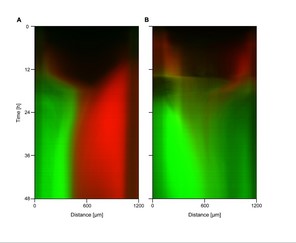 Spatiotemporal structures and heterogeneities are common in natural habitats, but their role in the evolution of antibiotic resistance remains to be discovered. In this research, scientists used a microfluidic gradient generator device to study the emergence of resistant bacteria.
Spatiotemporal structures and heterogeneities are common in natural habitats, but their role in the evolution of antibiotic resistance remains to be discovered. In this research, scientists used a microfluidic gradient generator device to study the emergence of resistant bacteria.
Emergence of Resistant Escherichia coli Mutants in Microfluidic On-Chip Antibiotic Gradients
Krisztina Nagy*, Barbara Dukic, Orsolya Hodula, Ágnes Ábrahám, Eszter Csákvár, László Dér, Miles T. Wetherington, Janneke Noorlag, Juan E. Keymer and Péter Galajda
Front. Microbiol.,Vol, 13, March 2022
https://doi.org/10.3389/fmicb.2022.820738
Active mixtures in a narrow channel: motility diversity changes cluster sizes
 The continuous motion of bacteria produces clusters with a stationary cluster size distribution.
The continuous motion of bacteria produces clusters with a stationary cluster size distribution.
Here, we develop a minimal model for bacteria in a narrow channel to assess the relative
importance of motility diversity and confinement. We show that the greater the diversity in the motilities -which occurs naturally in a biological situation- the larger the clusters.
Using parameters fitted from experiments with Escherichia coli bacteria, we predict that the error in estimating the average size without accounting for polydispersity is about 60%.
Active mixtures in a narrow channel: motility diversity changes cluster sizes
De Castro P.,Diles S., Soto R.,Sollichcd P.
Soft Matter http://rsc.li/soft-matter-journal.January 2021
DOI: 10.1039/d0sm02052d
PUBLICATIONS 2018-2020
E. coli “super-contaminates” narrow ducts fostered by broad run-time distribution
 One characteristic of bacterial motion is its capacity to swim upstream. This movement takes place in anatomic conducts or medical devices. In this study, we demonstrate that in microfluidic devices, E. coli can travel distances up to 15mm in just 15 minutes against the current. This effect, we denominate “super-contamination” due to the broad run-time distribution of the swim in the E. coli, could explain the rapid appearance of some potentially fatal medical emergencies.
One characteristic of bacterial motion is its capacity to swim upstream. This movement takes place in anatomic conducts or medical devices. In this study, we demonstrate that in microfluidic devices, E. coli can travel distances up to 15mm in just 15 minutes against the current. This effect, we denominate “super-contamination” due to the broad run-time distribution of the swim in the E. coli, could explain the rapid appearance of some potentially fatal medical emergencies.
E. coli “super-contaminates” narrow ducts fostered by broad run-time distribution
Figueroa-Morales N.; Rivera A., Soto R., Lindner A., Altshuler E., Clément E.
Science Advances 6 (11), eaay0155. (2020)
https://advances.sciencemag.org/content/6/11/eaay0155
Run-and-tumble bacteria slowly approaching the diffusive regime
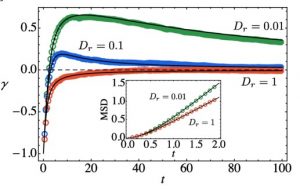 The bacteria run-and-tumble dynamic gives birth to both; a ballistic movement due to its
The bacteria run-and-tumble dynamic gives birth to both; a ballistic movement due to its
persistence and a diffusion process due to its consecutive tumbles. Here, we investigate how long
it takes for a diluted bacterial suspension to reach a diffusion regimen, likewise, the importance of
the deviations concerning this regime for intermediate times.
Run-and-tumble bacteria slowly approaching the diffusive regime
Villa-Torrealba A., Chávez-Raby C., De Castro P., Soto R.
Physical Review E101, 062607 (2020)
https://doi.org/10.1103/PhysRevE.101.062607
Understanding contagion dynamics through microscopic processes in active Brownian particles
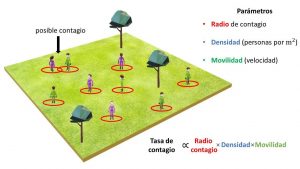 Along with the universally recognized SIR model, several approaches have been used to
Along with the universally recognized SIR model, several approaches have been used to
comprehend the contagion dynamics of the interacting particles. Here, active Brownian
particles (ABP) are introduced to model the contagion dynamics of living agents that
perform a horizontal transmission in time and space of an infectious disease..
Understanding contagion dynamics through microscopic processes in active Brownian particles.
Norambuena, A., Valencia, F. J., Guzmán-Lastra, F.
Scientific Reports, 10(1), 1-7. (2020).
https://www.nature.com/articles/s41598-020-77860-y
Towards an analytical description of active microswimmers in clean and in surfactant-covered drops
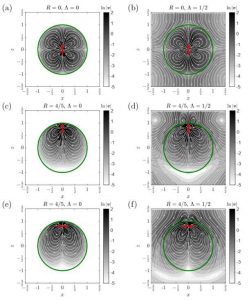 Based on a far-field analytical model, the low-Reynolds-number locomotion of a self-propelled microswimmers moving inside a clean viscous drop or a drop covered with a homogeneously distributed surfactant, is theoretically examined. We find that the
Based on a far-field analytical model, the low-Reynolds-number locomotion of a self-propelled microswimmers moving inside a clean viscous drop or a drop covered with a homogeneously distributed surfactant, is theoretically examined. We find that the
presence of the surfactant significantly alters the dynamics of the encapsulated swimmer by enhancing its reorientation..
Towards an analytical description of active microswimmers in clean and in surfactant-covered drops.
Sprenger, A. R., Shaik, V. A., Ardekani, A. M., Lisicki, M., Mathijssen, A. J., Guzmán-Lastra, F Löwen H., Menzel A., Daddi-Moussa-Ider A.
The European Physical Journal E, 43(9), 1-18. (2020).
https://link.springer.com/article/10.1140/epje/i2020-11980-9
Diffusion in a porous media
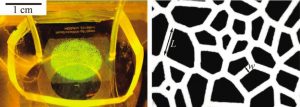 Diffusion is a universal process of high importance, for example, in the transport of molecules inside the cells, chemical signals inside the brain, or nutrients in the soil. The geometry of the media has a strong influence in the process, and that is what we demonstrate in the present study, where we used several random microchannels networks to experimentally determine the effect of the effective area of the networks and the size of the measurement area in the effective properties of the same.
Diffusion is a universal process of high importance, for example, in the transport of molecules inside the cells, chemical signals inside the brain, or nutrients in the soil. The geometry of the media has a strong influence in the process, and that is what we demonstrate in the present study, where we used several random microchannels networks to experimentally determine the effect of the effective area of the networks and the size of the measurement area in the effective properties of the same.
Local details versus effective medium approximation: A study of diffusion in microfluidic random networks made from Voronoi tessellations.
W. Ponce, M. L. Cordero.
Phys. Rev. E 101, 023110 (2020).
https://doi.org/10.1103/PhysRevE.101.023110
Hybrid micromotors for detection of gastric cancer
 In the present article, we study tiny micromotors formed by microtubes of different materials, so they can show different properties. This study was especially about catalytic micromotors (impulsed using a chemical reaction), magnetic micromotors (impulsed using an external magnetic field), or hybrid micromotors (impulsed by a mixture of both processes.)
In the present article, we study tiny micromotors formed by microtubes of different materials, so they can show different properties. This study was especially about catalytic micromotors (impulsed using a chemical reaction), magnetic micromotors (impulsed using an external magnetic field), or hybrid micromotors (impulsed by a mixture of both processes.)
Effects of preparation on catalytic, magnetic and hybrid micromotors on their functional features and application in gastric cancer biomarker detection.
D. F. Báez, Ramos, A. Corvalán, M. L. Cordero, S. Bollo, M. J. Kogan.
Sens. Act. B 310, 127843 (2020).
https://doi.org/10.1016/j.snb.2020.127843
Nonideal rheology of semi-dilute bacterial suspensions
 IIn this article, we study the viscous response of bacterial suspensions in a semi-dilute regimen.
IIn this article, we study the viscous response of bacterial suspensions in a semi-dilute regimen.
Considering the interactions that create alignment between bacteria, we showed that the viscous
effort produced by the bacterial activity is oscillatory, even with a stationary flux.
Nonideal rheology of semidilute bacterial suspensions
Guzmán M., Soto R.
Physical Review e99, 012613 (2019)
https://doi.org/10.1103/PhysRevE.99.012613
Cell migration driven by substrate deformation gradients
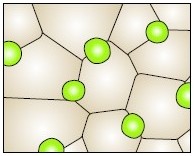 This study proposes the existence of a mechanism that is similar to another mechanism already
This study proposes the existence of a mechanism that is similar to another mechanism already
known -named durotaxis-, where cells, instead of migrating to the hard zones, migrate to the
stretched zones. We postulate that some cases of cellular migration, where cells move guided by
chemical signs, can be cases of “straintaxis” and not only durotaxis, as previously believed.
Cell migration driven by substrate deformation gradients
Márquez S., Reig G., Concha M. Soto R.
Phys. Biol. 16 (2019) 066001
https://doi.org/10.1088/1478-3975/ab39c7
Active colloidal chains with cilia- and flagella-like motion
In this study we demonstrate that simplified systems, consisting only of a few particles with non-reciprocal interaction and head–tail asymmetry, show beating motion and self-propulsion. Both properties are present in many non-equilibrium models thus making our results a general feature of active matter.
Active colloidal chains with cilia- and flagella-like motion
González y R. Soto
New Journal of Physics 20,053014 (2018)
http://iopscience.iop.org/article/10.1088/1367-2630/aabe3c
Vertex model instabilities for tissues subject to cellular activity or applied stresses
 The vertex model is widely used to describe the epithelial tissues dynamic due to its simplicity and
The vertex model is widely used to describe the epithelial tissues dynamic due to its simplicity and
versatility and the easy inclusion of biophysics parameters. This study shows that when cells
modify their equilibrium perimeter because of its activity, or the tissues are subject to external
tensions, the tissue becomes unstable, and cells become considerably deformed. These deformations could be able to trigger morphogenetic processes.
Vertex model instabilities for tissues subject to cellular activity or applied stresses
Pérez F., Joanny J., Soto R.
Physical Review E102, 052604 (2020). https://doi.org/10.1103/PhysRevE.102.052604
Does the 3D Spatial exploration reflect the temporal variability of the E. coli motor?
 Most of the theoretical approaches used to model bacteria transport have their base on its run-and-tumble movement. It is typically supposed that the rate of tumbles is constant. By studying the tridimensional trajectories of E. coli, we show there is extensive variability in the behavior of E. coli, characterized by a fluctuant rate of tumbles related to the chemotaxis mechanism of this bacteria.
Most of the theoretical approaches used to model bacteria transport have their base on its run-and-tumble movement. It is typically supposed that the rate of tumbles is constant. By studying the tridimensional trajectories of E. coli, we show there is extensive variability in the behavior of E. coli, characterized by a fluctuant rate of tumbles related to the chemotaxis mechanism of this bacteria.
3D Spatial Exploration by E. coli Echoes Motor Temporal Variability
Figueroa-Morales N., Soto R, Junot G.,Darnige T.,Douarche C. ,Martínez V. , Lindner A., Clement E.
https://doi.org/10.1103/PhysRevX.10.021004
Bacteria driving droplets
 In this study, we confined bacteria inside microdroplets. Bacteria swim inside de drop, merge and form ephemeral structures, causing the drop motion. Like the bacteria motion, the drop motion is also fluctuant and aleatory, and this fact is related to the movement of bacteria near the drop surface.
In this study, we confined bacteria inside microdroplets. Bacteria swim inside de drop, merge and form ephemeral structures, causing the drop motion. Like the bacteria motion, the drop motion is also fluctuant and aleatory, and this fact is related to the movement of bacteria near the drop surface.
Bacteria driving droplets
G. Ramos, M. L. Cordero, R. Soto.
Soft Matter 16, 1359 (2020).
https://doi.org/10.1039/C9SM01839E
Active carpets drive non-equilibrium diffusion and enhanced molecular fluxes
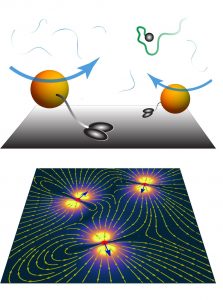 These ‘active carpets’ locally inject energy into their surrounding fluid. Whereas Fick’s laws of diffusion are established near equilibrium, it is unclear how to solve non-
These ‘active carpets’ locally inject energy into their surrounding fluid. Whereas Fick’s laws of diffusion are established near equilibrium, it is unclear how to solve non-
equilibrium transport driven by such boundary-actuated fluctuations. Here, we derive the enhanced diffusivity of molecules or passive particles as a function of distance from an active carpet.
Active carpets drive non-equilibrium diffusion and enhanced molecular fluxes.
Guzmán-Lastra, F., Löwen, H., & Mathijssen, A. J.
Nature Communications, 12(1), 1-15. (2021).
https://www.nature.com/articles/s41467-021-22029-y
Perfect Brewster transmission through ultrathin perforated films
 When an acoustic wave has incidence in a perforated film, the wave transmission is
When an acoustic wave has incidence in a perforated film, the wave transmission is
typically low, except for certain particular angles named Brewster angles.
We study, theoretically and numerally, the effect of the acoustic properties and the
geometry of the surface in the wave transmission.
Perfect Brewster transmission through ultrathin perforated films.
K.Pham, A.Maurel ,J.-F.Mercier, S.Félix, M.L.Cordero, C.Horvath
Wave motion 93, 102485 (2020).
https://doi.org/10.1016/j.wavemoti.2019.102485
Membrane penetration and trapping of an active particle
In this article, we explore the interaction between an active particle and a cell membrane. We show that the active particle may either get trapped near the membrane or penetrate through it, where the membrane can either be permanently destroyed or recover its initial shape by self-healing. We also present state diagrams that carefully outline which state occurs in terms of only a few generic aspects; membrane elasticity, bending rigidity, resistance, and size of the active particle.
Membrane penetration and trapping of an active particle.
Daddi-Moussa-Ider, A., Goh, S., Liebchen, B., Hoell, C., Mathijssen, A. J., Guzmán-Lastra, F.,Scholz C., Menzel A., Löwen H.
The Journal of chemical physics, 150(6), 064906 (2019).
https://aip.scitation.org/doi/abs/10.1063/1.5080807
GPU parallel simulation algorithm of Brownian particles
In this article, we developed an algorithm that allows us to simulate computationally millions of microscopic particles. Using advanced geometric tools, we perform an efficient
simulation in graphic units (GPU). In the image, we show the case of a mixture of gold and platinum particles in an
oxygenated water solution.
GPU parallel simulation algorithm of Brownian particles with excluded volume using Delaunay triangulations
F Carter, N Hitschfeld, C Navarro, R Soto
Computer Physics Communications 229, 148 (2018)
https://www.sciencedirect.com/science/article/pii/S0010465518301061
Magnetotactic bacteria in a droplet self-assemble into a rotary motor
 A class of bacteria, called magnetotactic (MTB), are organisms that naturally can grow an internal microscopic magnet that allows them to align with an external magnetic
A class of bacteria, called magnetotactic (MTB), are organisms that naturally can grow an internal microscopic magnet that allows them to align with an external magnetic
field.When we confine them inside a microdroplet and apply a constant magnetic field, bacteria start swimming in circles making the drop rotate.
Magnetotactic bacteria in a droplet self-assemble into a rotary motor. Vincenti, G. Ramos, M. L. Cordero, C. Douarche, R. Soto, E.Clément. Nature Communications, 10, 5082 (2019)
https://doi.org/10.1038/s41467-019-13031-6
Propiedades críticas de materiales granulares
Los fenómenos críticos asociados a la transición de líquido a sólido de sistemas granulares vibrados cuasi bidimensionales se estudian utilizando simulaciones de dinámica molecular del modelo de esfera dura inelástica. En este estudio vemos que en sistemas cuasi unidimensionales, la transición es solo discontinua, limitada por un punto crítico, lo que indica que dos es la dimensión más baja por tener un punto tricrítico.
Critical phenomena in quasi-two-dimensional vibrated granular systems
M Guzmán, R Soto
Physical Review E 97, 012907 (2018)
https://journals.aps.org/pre/abstract/10.1103/PhysRevE.97.012907
PUBLICATIONS 2010 – 2017
| Autores/Authors | Título/Title | Referencia/Reference |
|---|---|---|
| G Castillo, N Mujica, N Sepulveda, J C Carlos Sobarzo, M Guzman, R Soto | Hyperuniform states generated by a critical friction field | Phys. Rev. E (accepted 2019) |
| S Marquez, G Reig, M Concha, R Soto | Cell migration driven by substrate deformation gradients | Phys. Biol. (accepted 2019) |
| A Daddi-Moussa-Ider, S Goh, B Liebchen, C Hoell, AJTM Mathijssen, F Guzmán-Lastra, C Scholz, AM Menzel, H Löwen | Membrane penetration and trapping of an active particle | J. Chem. Phys. 150, 064906 (2019) |
| Gaspard Junot, Nuris Figueroa-Morales, Thierry Darnige, Anke Lindner, Rodrigo Soto, Harold Auradou, Eric Clément | Swimming bacteria in Poiseuille flow: The quest for active Bretherton-Jeffery trajectories | EPL 126, 44003 (2019) |
| S Gonzalez, R Soto | Directed assembly of active colloidal molecules | New Journal of Physics 21, 033041 (2019) |
| M Guzmán, R Soto | Nonideal rheology of semidilute bacterial suspensions | Phys. Rev. E 99, 012613 (2019) |
| N Sepúlveda, R Soto | Universality of active wetting transitions | Phys. Rev. E 98, 052141 (2018) |
| V Garzó, R Brito, R Soto | Enskog kinetic theory for a model of a confined quasi-two-dimensional granular fluid | Phys. Rev. E 98, 052904 (2018) |
| N. Hassan, M.L. Cordero, R. Sierpe, M. Almada, J. Juárez, M. Valdez, A. Riveros, E. Vargas, Ali Abou-Hassan, J.M. Ruso, M.J. Kogan | Peptide functionalized magneto-plasmonic nanoparticles obtained by microfluidics for inhibition of β-amyloid aggregation | J. Mater. Chem. B 6, 5091 (2018) |
| D Risso, R Soto, M Guzmán | Effective two-dimensional model for granular matter with phase separation | Phys. Rev. E 98, 022901 (2018) |
| F. Barra and C. Lledó | The smallest absorption refrigerator: the thermodynamics of a system with quantum local detailed balance | EPJ-ST 227, 231 (2018) |
| AJTM Mathijssen, F Guzmán-Lastra, A Kaiser, H Löwen | Self-organised active carpets drive replenishing nutrient currents | Phys. Rev. Lett. 121, 248101 (2018) |
| S. González and R. Soto | Active colloidal chains with cilia- and flagella-like motion | New Journal of Physics 20, 053014 (2018) |
| M Guzmán, R Soto | Critical phenomena in quasi-two-dimensional vibrated granular systems | Physical Review E 97, 012907 (2018) |
| F Carter, N Hitschfeld, C Navarro, R Soto | GPU parallel simulation algorithm of Brownian particles with excluded volume using Delaunay triangulations | Computer Physics Communications 229, 148 (2018) |
| J. Thingna, F. Barra, M. Esposito | Kinetics and thermodynamics of a driven open quantum system | Phys. Rev. E 96 052132 (2017) |
| German Reig, Mauricio Cerda, Néstor Sepúlveda, Daniela Flores, Victor Castañeda, Masazumi Tada, Steffen Härtel and Miguel Concha | Extra-embryonic tissue spreading directs early embryo morphogenesis in killifish | Nature Communications 8, 15431 (2017) |
| F. Barra and C. Lledó | Stochastic thermodynamics of quantum maps with and without equilibrium | Phys. Rev. E 96, 052144 (2017) |
| N Sepúlveda and R Soto | Wetting transitions displayed by persistent active particles | Phys. Rev. Lett. 119, 078001 (2017) |
| B Herrmann-Priesnitz, WR Calderón-Muñoz, A Valencia, R Soto | Thermal design exploration of a swirl flow microchannel heat sink for high heat flux applications based on numerical simulations | Applied Thermal Engineering 109, 22-34 (2016) |
| Néstor Sepúlveda and Rodrigo Soto | Coarsening and clustering in run-and-tumble dynamics with short-range exclusion | Phys. Rev. E 94, 022603 (2016) |
| N Mujica and R Soto | Dynamics of noncohesive confined granular media | Recent Advances in Fluid Dynamics with Environmental Applications, 445(2016) |
| D.Churochkin, F. Barra, F. Lund, A. Maurel, V. Pagneux | Multiple scattering of elastic waves by pinned dislocation segments in a continuum | Wave Motion, 60 220 (2016) |
| F. Barra and M. Esposito | Dissipation in small systems: Landau-Zener approach. | Phys. Rev. E. 93, 062118 (2016) |
| F. Barra, R. Espinoza-González, H. Fernández, F. Lund, A, Maurel and V. Pagneux | The Use of Ultrasound to Measure Dislocation Density | Jom 67, 1856 (2015) |
| F. Barra | The thermodynamic cost of driving quantum systems by their boundaries | Scientific Reports 5, 14873 (2015) |
| P. Cordero, D. Risso and R. Soto | Effect of the vibration profile on shallow granular systems | Phil. Trans. R. Soc. A 373, 20150116 (2015) |
| E. Rojas, M. Trulsson, B. Andreotti, E. Clement and R. Soto | Relaxation processes after instantaneous shear rate reversal in a dense granular flow | EPL 109, 64002 (2015) |
| Rodrigo Soto and Ramin Golestanian | Self-assembly of Active Colloidal Molecules with Dynamic Function | Phys. Rev. E 91, 052304 (2015) |
| G. Castillo, N, Mujica, and R. Soto | Universality and criticality of a second-order granular solid-liquid-like phase transition | Phys. Rev. E 91, 012141 (2015) |
| J.-F. Mercier, M. L. Cordero, S. Félix, A. Ourir, and A. Maurel | Classical homogenization to analyze the dispersion relations of spoof plasmons with geometrical and compositional effects | Proc. R. Soc. A 471, 20150472 (2015) |
| Cordero, ML; Maurel, A; Mercier, JF; Felix, S; Barra, F | Tuning the wavelength of spoof plasmons by adjusting the impedance contrast in an array of penetrable inclusions | Appl. Phys. Lett. 107, 084104 (2015) |
| Horvath, C;Arratia, C;Cordero, ML | Measurement of the dispersion relation of a convectively unstable capillary jet under confinement | Physics of Fluids 27, 114103 (2015) |
| R. Soto, D. Risso, and R. Brito | Shear viscosity of a model for confined granular media | Physical Review E 2014 |
| C. Parra-Rojas and R. Soto | Casimir effect in swimmer suspensions | Physical Review E 2014 |
| B. Néel, I. Rondini, A. Turzillo, N. Mujica, and R. Soto | Dynamics of a first-order transition to an absorbing state | Physical Review E 2014 |
| Rodrigo Soto and Ramin Golestanian | Self-assembly of catalytically active colloidal molecules: Tailoring activity through surface chemistry | Phys. Rev. Lett. 2014 |
| Rodrigo Soto and Ramin Golestanian | Run-and-tumble in a crowded environment: persistent exclusion process for swimmers | Physical Review E 2014 |
| S. Ajisaka, F. Barra and B. Zunkovic | Nonequilibrium quantum phase transitions in the XY model: comparison of unitary time evolution and reduced density matrix approaches | New. J. Phys 16 (2014) 033028 |
| Ulloa, C;Ahumada, A;Cordero, ML | Effect of confinement on the deformation of microfluidic drops | Physical Review E 2014 |
| S. Ajisaka and F. Barra | Nonequilibrium mesoscopic Fermi-reservoir distribution and particle current through a coherent quantum system | Phys. Rev. B 87 195114 (2013) |
| C. Parra-Rojas and R. Soto | Active temperature and velocity correlations produced by a swimmer suspension | Physical Review E 2013 |
| Francisca Guzman-Lastra and Rodrigo Soto | Subdiffusive behavior of a dilute non-Brownian suspension under shear | Physical Review E 2013 |
| R. Brito, D. Risso, and R. Soto | Hydrodynamic modes in a confined granular fluid | Physical Review E 2013 |
| G. L. Miño *, J. Dunstan*, A. Rousselet, E. Clement , and R. Soto | Induced Diffusion of Tracers in a Bacterial Suspension: Theory and Experiments | J. Fluid Mech 2013 |
| L.-H. Luu, N. Mujica, and R. Soto | Capillarylike fluctuations of a solid-liquid interface in a noncohesive granular system | Phys. Rev. E 2013 |
| Francisca Guzman-Lastra and Rodrigo Soto | Stochastic resonance on the transverse displacement of swimmers in an oscillatory shear flow | Phys. Rev. E 2012 |
| G. Castillo, N. Mujica, and R. Soto | Fluctuations and Criticality of a Granular Solid-Liquid-like Phase Transition | Physical Review Letter 2012 |
| N. Rivas, P. Cordero, D. Risso, and R. Soto | Characterization of the energy bursts in vibrated shallow granular systems | Granular Matter 2012 |
| Jocelyn Dunstan, Gastón Miño*, Eric Clement , Rodrigo Soto | A two-sphere model for bacteria swimming near solid surfaces | Physical Fluids 2012 |
| S. Ajisaka, F. Barra, C. Mejía-Monasterio, and T. Prosen | Current in coherent quantum systems connected to mesoscopic Fermi reservoirs | Physica Scripta 2012 |
| F. Barra, F. Lund, N. Mujica and S. Rica | Shear modulus of an elastic solid under external pressure as a function of temperature: The case of helium | Physical Review B 2012 |
| S. Ajisaka, F. Barra, C. MejíaMonasterio, and T. Prosen | Nonequlibrium particle and energy currents in quantum chains connected to mesoscopic Fermi reservoirs | Physical Review B. 2012 |
| F. Barra, V. Pagneux and J. Zuñiga | Diffusive transport of waves in a periodic waveguide | Physical Review E 2012 |
| S. Ajisaka, F. Barra, C. Mejía-Monasterio, and T. Prosen | Particle and energy transport in quantum disordered and quasi-periodic chains connected to mesoscopic Fermi reservoirs | AIP Conference Proceedings 2012 |
| P. Rodríguez-Lopez, R.Brito and R. Soto | Numerical computation of Casimir forces via stochastic quantization | Int. J. Mod. Phys. Conf. Ser. 2012 |
| N. Rivas, D. Risso, R. Soto, and P. Cordero | Energy bursts in vibrated shallow granular systems | AIP Conf. Proc. 2011 |
| Nicolás Rivas, Patricio Cordero, Dino Risso, and Rodrigo Soto | Segregation in quasi two-dimensional granular system | New Journal of Physics 2011 |
| Daniel Asenjo, Fernando Lund, Simón Poblete, Rodrigo Soto, Marcos Sotomayor | Characterization of the Melting Transition in Two Dimensions at Vanishing External Pressure Using Molecular Dynamics Simulations | Physical Review B 2011 |
| N. Rivas, S. Ponce, B. Gallet, D. Risso, R. Soto, P. Cordero, and N. Mujica | Sudden chain energy transfer events in vibrated granular media | Physical Review Letter 2011 |
| Pablo Rodriguez-Lopez*, Ricardo Brito , and Rodrigo Soto | Stochastic Quantization and Casimir Forces | EPL 2011 |
| Cordero, ML;Gallaire, F;Baroud, CN | Quantitative analysis of the dripping and jetting regimes in co-flowing capillary jets | Physics of Fluids2011 |
| Shuichi Tasaki, Shigeru Ajisaka and Felipe Barra | Quantum statistical mechanics in infinitely extended systems - C* algebraic approach | Bussei Kenkyu, 97, No. 3 483 (2011) |
| G. Miño, T.E. Mallouk, T. Darnige, M. Hoyos, J. Dauchet, J. Dunstan, R. Soto, Y. Wang, A. Rousselet, and E. Clement | Enhanced diffusion due to active swimmers at a solid surface | Phys. Rev. Letter 2011 |
| A. Maurela, V. Pagneuxb, F. Barra, F. Lund | Surface acoustic waves in interaction with a dislocation | Ultrasonics 2010 |
| Barra F, Maurel A, Pagneux V, Zuñiga J. | Number of propagating modes of a diffusive periodic waveguide in the semiclassical limit | Physical Review E 2010 |



